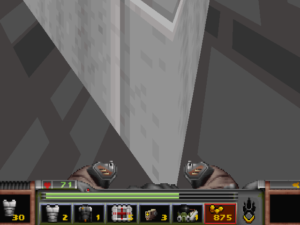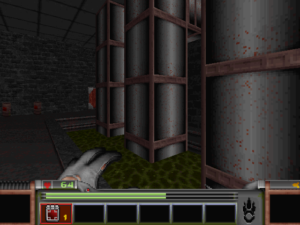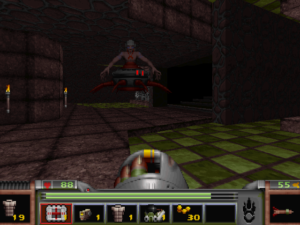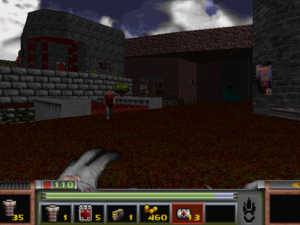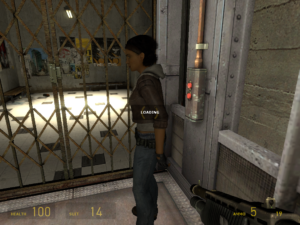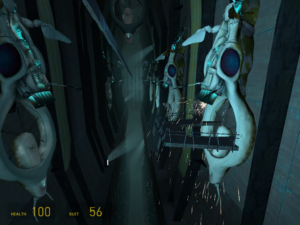Strife: Rising Action
There’s a pattern you can see in a lot of games of a sort of repeated crescendo of rising action. Each chapter builds up to a boss fight, and when it’s over, a relatively subdued segment allows you to catch your breath. So it is in Strife.
The chapters in this case don’t correspond directly to levels. Rather, a new chapter introduces a new hub area, where you can shop for equipment and wander unmolested as long as you don’t shoot anything. Somewhere off the hub is a boss fight that is your objective for the chapter, but it’s inaccessible until you complete a sub-goal or two in other areas, some of which are what I’ve been thinking of as stealth missions.
Please understand that I use the word “stealth” here in a very broad sense. This isn’t Thief we’re talking about here. I mean missions in which the regular guards (or Acolytes of the Order, as they’re called) won’t attack you on sight, but which contain either alarmed areas, or creatures that will attack you, prompting you to attack back and trigger an alarm by shooting. Triggering an alarm eventually is inevitable, but you can try to put it off for as long as possible, and lessen the alarm’s effect by killing Acolytes in advance: the crossbow, when loaded with poison bolts, kills them instantly, and is the one weapon that doesn’t raise an alarm. (It’s completely ineffective on anything mechanical, of course, which includes pretty much everything other than Acolytes and innocent bystanders.) When you’re firing the crossbow through a window into an alarmed area that you’re going to go through later, this can feel very much like a stealth game. On the other hand, when you walk right up to a guard and shoot him point-blank in full view of a bunch of other guards who just stand there and watch, it just feels like you’re taking unfair advantage of a gameplay mechanic that wasn’t thought out very well.
After stealth mode comes Doom mode. The monsters become tougher and/or more numerous, especially as you near the boss, and you bring out your heavier weapons. The idea here is, I suppose, to soften you up — to make sure that you don’t enter into the boss fight in peak condition. Strangely, this is probably helps the player overall, because it means that the boss is calibrated to provide a challenge for a hurt player with depleted ammo, and thus skillful play beforehand can put you ahead of the curve. I’m comparing this in my mind to the endless boss fights in Serious Sam, which were generally preceded by a roomful of supplies and even spawned more supplies during the fight, just to extend the experience.
Since the binding goal of the game is to collect the five pieces of the Sigil, you’d probably think that each piece comes at the end of a chapter of the sort I’ve just described. And that’s more or less the case, except for two, which are pretty much outside the chapter structure. After you obtain the first piece, Macil sends you to find an Oracle who will help you get the rest. The Oracle tells you how to get one more piece, then tells you that Macil has the next piece and that you should kill him. This is a major branch in the plot: you can choose to trust the Oracle, or you can choose to trust Macil. In fact, they both have pieces of the Sigil, but killing them both immediately seems to break the plot. At any rate, they’re both located in places you’ve already been to by that point, so there’s no ramping up of the action just to reach them.
Macil’s death was something of a disappointment. When you kill him, he emits a Spectre, a cloud-like entity that can only be hurt by the Sigil, and the entire resistance movement immediately realizes the truth: Macil was an agent of the Order all along, and was betraying them. This is an unnecessary development, unless you want your morally-tricky world, with its lesser-of-two-evils allies, to resolve into simple black-and-white. Which is what happens. With Macil’s corrupting influence purged, his second-in-command takes control of the Front, and suddenly they’re just good guys. I suppose I shouldn’t have expected otherwise.
 0 Comments
0 Comments